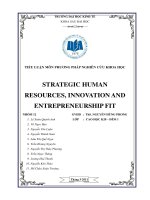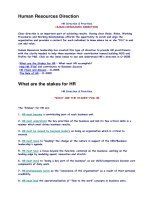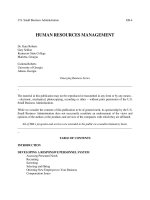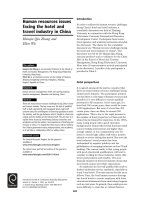EMPLOYEE RETENTION HUMAN RESOURCES
Bạn đang xem bản rút gọn của tài liệu. Xem và tải ngay bản đầy đủ của tài liệu tại đây (233.8 KB, 18 trang )
EMPLOYEE RETENTION
1
TABLE OF CONTENT
SUMMARY.......................................................................................................................................................... 3
I. THEORETICAL REVIEW ON EMPLOYEE RETENTION........................................................................4
1.1 Definition of Employee Retention.................................................................................................................... 4
1.2 Problem Statement................................................................................................................................................. 4
1.3 Maslow’s hierarchy of needs.............................................................................................................................. 5
1.4 Herzberg’s two factor theory.............................................................................................................................. 7
1.5 Employee Retention Strategy............................................................................................................................. 7
II. FACTORS LEADING TO EMPLOYEE RETENTION................................................................................9
2.1 Compensation........................................................................................................................................................... 9
2.2 Organizational culture or working climate................................................................................................... 9
2.3 Human relation and leadership...................................................................................................................... 10
2.4 Support..................................................................................................................................................................... 10
2.5 Job Satisfaction...................................................................................................................................................... 10
2.6 Organizational commitment............................................................................................................................ 11
2.7 Job Engagement..................................................................................................................................................... 11
2.8 Job Embeddedness............................................................................................................................................... 12
III. EXAMPLES OF RETENTION PRACTICES IN CERTAIN COMPANY...............................................13
CONCLUSION................................................................................................................................................... 16
REFERENCES................................................................................................................................................... 17
SUMMARY
“Employee retention” nowadays becomes commonly used to demonstrate a particular area of
business field.
Talented employee are considered as the most valuable assets of any organization but currently
many companies are facing turnover of talented employees. In many companies, Human Resource
department have thought of strategies of human resource management in order to prevent
voluntary quitting of the talents and keep them for organization’s success. In other words, in
current business environment, retention management has become a very essential task for any
organization.
Regarding the retention management, there are many factors resulting in a turnover of employees
and explaining that why employee wants to remain in organization and make them stay with the
organization.
Finally, this paper introduces an example of employee retention in PAETEC Holding Corporation
and shows how the company makes their employees loyal and more engage.
I. THEORETICAL REVIEW ON EMPLOYEE RETENTION
1.1 Definition of Employee Retention
Employees are an asset of an organization. The more time an employee spends in an
organization, the more experienced the employee gets and becomes more valuable to the
organization. Employee retention means an effort by a business to maintain a working
environment which supports current staff in remaining with the company. Many employee
retention policies are aimed at addressing the various needs of employees to enhance their job
satisfaction and reduce the substantial costs involved in hiring and training staff. Nowadays, a
number of organizations are facing with many problems in employee retention. There is no doubt
that hiring well – educated people for the job is essential for an employer, but retention is even
more important than hiring. Imagine that a person is not satisfied by the job he or she is doing, he
might switch over to some more suitable job. There are various reasons lead to employees leave
organizations. These reasons should be understood and taken care of by the organizations. Most
organizations are becoming aware of these reasons and are adopting many strategies for
employee retention.
1.2 Problem Statement
Retaining employees is a dilemma that many companies are facing; hence identifying the
root cause is a good approach. Companies must be proactive and not wait for employees to start
leaving then react by analyzing likely reasons. In order to retain top employees, leaders and HR
(Human Resource) departments ought to spend large amounts of time, effort and money.
Understanding employee perspectives and measuring their retention factors are critical to an
organization success. Most of these are directly related to creating a satisfactory work
environment for employees and to good retention, an organization has to provide and support
their employees by features or motivators:
An energetic work environment that make effective uses of employee’s skills and
knowledge allows them a degree of autonomy on the job, provides an avenue for them to
contribute ideas, and allows them to see how their own contribution influence the
company’s well-being.
Opportunities for learning, being promoted and recognized
Good compensation and adequate, flexible benefit plans.
Recognition on the part of the employer that employees need to strike a good balance
between their lives at work and outside of work.
Respect and support from peers and their boss
Besides, there are other aspects of inside problems or particular jobs that can act as strong ‘demotivators’ that can cause people to leave their employment:
Feeling bored or unchallenged by repetitive tasks
Lack of job security
Lack of learning opportunities
Concerns about the future of the job/ career
It is important to note that some of these de-motivators can occur at the best of
organizations, or can be the result of forces that originate the company itself or outside problems.
That employees are often pulled to other companies or industries by more generous offers is, in
part, a result of the broad characteristics of an industry or the segment of the market in which the
company operates. It is also clear that people are more likely to stay if the perceived workplace
culture is a good “fit” with the individual’s own interests, orientation and attitudes suggest that
compensation, personal and professional development opportunities, how it treats employees,
what it expects of them, and how people relate to one another in the workplace. and other
incentives are important in attracting people and keeping them happy, their decision to stay with
the company.
1.3 Maslow’s hierarchy of needs
Abraham Maslow developed a Humanistic perspective of human motivation, it is a blend of
biological and social needs (Adler 2002; Newstrom and Davis ,2002). With Maslow, employees’s
demand are not of balance, and they emerge a definite sequence. The most simple demands (like
food, air, water and sleep) are neccessary to daily survival and are on the top of the pyramid of
the hierarchy of needs while needs that are less important to staying alive are higher on the
pyramid. He pointed out five levels in this pyramid:
1. Physiological needs – e.g. food, air, water and sleep
2. Safety and security needs – e.g. freedom from a dangerous work environment; a no lay –
off guarantee; comfortable retirement plan.
3. Belonging and social needs – e.g. friendships; love and affection from family members;
compatible associates.
4. Esteem and status needs – e.g. feelings of self – worth; competence; recognition from
others for the job one does.
5. Self-actualization – e.g. capacity to become what one can become; stretching talents to the
maximum.
This model is easy to organizations use and analysis the basic needs of all of their employees, and
from it they get employees to improve on their performance and improve the quality of their
results
1.4 Herzberg’s two factor theory
Following Herzberg Theory, he argued that employees are retentive by internal values
rather than values that are external to the work. In other words, motivation is internally
generated and is propelled include achievement, recognition, the work itself, responsibility,
advancement, and growth.
According to Herzberg, (1959), individuals will not stay at an organization if lowerorder
needs at work, for example, those low minimum salary levels or unsafe and they will be pleasant
in working if they look for achievement, recognition, responsibility, advancement.
So far, this appears to parallel Maslow's theory of a need hierarchy. However, Herzberg,
(1959), added a new dimension to this theory by proposing a two-factor model of motivation,
based on the notion that the presence of one set of job characteristics or incentives lead to
worker satisfaction at work, while another and separate set of job characteristics lead to
dissatisfaction at work. Thus, satisfaction and dissatisfaction will be linked with employee
retention in an organization.
1.5 Employee Retention Strategy
In the age of competition every organization tries its level best to give the best facilities to
its employees, satisfying the human sources is one of the toughest tasks which majority of the
organizations faces today. Understanding and knowing what is going on in the human mind is
very difficult to understand. Besides there are so many opportunities available for the skilled as
well as talented human resources that it is becoming very tough as well as difficult for the
employers to satisfy and retain them. There is no single strategy or retention plan which may
satisfy each and every employee in an organization.
C J
S
O
J
H
o o
u
r
u
mb
p
g
b
m
p a
a
E E
e
o
n
n
S
r m
i
n
a
g b
s
t
z
r
t
a e
i
t d
g
l
s
e d
i
a
f
o e
m
t
a
n d
e
i
c
n n
a
o
t
l e
t
n
i
o
s
c n
s
a
u n
o
md
l
t
m
i l
u
r e
t
e a
m
e d
o e
n
r
t
r
s
w h
o i
r p
k
i
n
g
c
l
i
m
a
t
e
Figure 1: Conceptual framework for factors influence the Employee Retention
Losing your best people damages your productivity, disrupts current and potential leadership, reduces team morale and also
helps your competitors. Matching a competitor’s job offer in order to retain your top performers is not a retention strategy and it
only encourages more employees to seek outside job offers. To avoid such a dilemma, the following serve as eight recommendations
that should be considered for retention strategy.
II. FACTORS LEADING TO EMPLOYEE RETENTION
Human resource plays an extremely important role for success of any organization. To
retain key employees, nowadays strategies of human resource management or retention
management have become necessary in any organization. To carry out retention management
effectively and set up retention strategies, it is necessary for HR (Human Resource) managers to
shift their focus to the reasons employees decided to stay with organization
There are many factors considered as main ones to promote employee retention:
2.1 Compensation
Compensation is defined as the payment of an employer to an employee for work required.
Compensation consists of the monetary payment like salary or wages and the non-cash payment
like benefits (life and health insurance, pension, retirement plan) and allowances, etc. These
monetary and non-monetary payments have a big impact on employees satisfaction, performance
and their desire to remain in the organization. It is true that compensation especially financial
compensation plays an important role in employees life. It makes employees feel that they are
fairly rewarded for their physical, cognitive and emotional investment into work. The more they
are feeling, the longer they want to stay in the organization.
This factor is considered as a valuable tool to attract and retain the employees.
2.2 Organizational culture or working climate
So as to keep the talents in the organization, HR (Human Resource) managers often pay
attention to compensation, reward system, so on to enhance their belongingness, loyalty towards
the organization. However, money is not all and the employee retention does not always depend
on money. Therefore, besides the compensation especially the money, other factors have been
considered for many years as well.
Among them, organizational culture or working environment is also an integral part of
retaining employees. In general it refers to the environment where employees both
learn and work. More specifically, it could be described by referring to: guidance and appreciation
at work; pressure of work; the amount of empowerment and the responsibility that employees
experience; choice in job tasks and development; provision of challenging and meaningful work;
and advancement and development opportunities. This factor is considered as a significant
predictor of organizational performance, especially employee retention.
2.3 Human relation and leadership
Human relation in organization consists of the relationship between employees and
leaders, the relationship between employees and coworkers. Good human relation has effects to
reduce turnover of employees and enhance retention. Particularly, in the relationship between
employees and employers, the concept “leadership” is often mentioned in many studies. Some
leadership styles are servant leadership, transforming leadership, empowering leadership,
leader-member exchange leadership, etc.
Certainly, if the trust, respect, contribution, influence come from good relationship between
leader and employees, the employees will have a feeling to like working in organization for long
period of time. In addition, beside emotional relationship, the employees also hope to receive
more and more support from their leader. Then, it is necessary for leaders to act behaviors to help
employees promote their meaningful sense, self-determination sense, competence, achievement
sense. In an organization, beside the relation between leader and employees, the relation
between coworkers and employees should be often paid attention. A good interaction with
coworkers and their support make employees have a sense of attachment to the organization and
they are less likely to quit.
Human relation and leadership in any organization play an important role in promoting
employees motivation, their sense of accomplishment and staying intention.
2.4 Support
Beyond the relationship between leaders and coworkers, the employees need to support
from them or organization to perform their job. These supports have effects to improve
employees skills, experiences, etc and make them perceive that they are being cared by others in
the organization. Especially, emotional support from organization, leaders and coworkers is
confirmed as a significant factor having a positive relation to employees retention.
2.5 Job Satisfaction
Job satisfaction is understood as the combination of physiological, psychological and
environmental circumstances causing a person satisfied with his/her job (Hoppock, 1935, p. 47).
Also, it is considered as positive feelings or emotional status resulting from the assessment of
one’s job (Yang, 2009). Employees generally do not leave a job in which they feel satisfied. If
people feel satisfied with their task or organization, they can work more effectively and have a
sense of belonging to their organization.
Job satisfaction depends on a number of things including salary, working environment,
autonomy, leadership, etc. However, it directly affects other factors such as organizational
commitment, performance, productivity, absenteeism, turnover, etc.
2.6 Organizational commitment
Organizational commitment is defined as identification and involvement of an employee
with the organization. It includes emotional feelings, belief, loyalty of an employee toward goals
and values of the organization, significant efforts to help the organization obtain its goal (Allen &
Meyer, 1990).
Organizational commitment has been affected by several factors such as compensation,
job characteristic, job career, supervisor relations, empowerment, autonomy, job satisfaction,
etc.However, it has had a significant and positive impact on job satisfaction, performance,
absenteeism, turnover, etc. The more committed an employee is, the longer he/ she desires to
remain in the same organization. These “highly committed” employees were found to have a
higher intent to remain with the company, a stronger desire to attend work, and a more positive
attitude about their employment.
2.7 Job Engagement
Recently, job engagement has appeared as a new concept to reflect emotional feelings of
an employee toward his/ her work. An employee is fully engaged in what he/she is doing or in
his/her organization if he/she recognizes his/her work to be personally meaningful, be
manageable and if he/she has hope and belief about the future of his/her work. Engaged
employee works hard to enhance performance and provides a competitive advantage to the
organization.
It consists of physical engagement, cognitive engagement and emotional engagement.
Firstly, physical engagement is the extent to which an employee contributes to organizational
goals. In this investment into work, an employee recognizes the importance of his/her role
toward work and strives as hard as to obtain higher levels of job performance. Secondly, cognitive
engagement is the extent to which an employee pays a lot of attention or concentrates on his/her
work. By taking note of, or focusing a great deal of attention on work, an employee can improve
performance quickly. Finally, emotional engagement is the extent to which an employee
empathizes with others at work, creates the connection among coworkers to enhance
performance of organization.
Job engagement impacts on individual and organization’s outcomes such as job
satisfaction, commitment, organizational citizenship behavior, productivity, profitability, intention
to quit, etc. About employee retention, the more physical, cognitive, emotional investment toward
work and organization are, the more engaged employee is and the longer he/she stays in
organization. Job engagement is considered as a key to predict retention of the talents and a good
level of engagement leads to high retention of employees.
2.8 Job Embeddedness
“Job embeddedness” has appeared to explain why employee decides to stay in his/ her
organization. It is defined it as “the combined forces that keep a person from leaving his or her
job. Job embeddedness describes on-the-job and off-the-job aspects and consists of three
dimensions: links, fit, sacrifice. Among them, “Links” are formal and informal connections
between an individual and other people, organization or community. The more an individual has
links with organization and community, the longer he/ she stays with his/her organization. “Fit”
means compatibility or comfort with his/her organization and community. If an individual’s goal
and values match the demands of his/ her job and needs of organization, he/ she desires to
remain for a long period of time. “Sacrifice” shows the perceived cost or benefits that can be
forfeited if an individual leaves from his/her organization or community (Mitchell et al, 2001).
Job embeddedness is considered as a significant predictor of employee retention beyond
job satisfaction and organizational commitment.
III. EXAMPLES OF RETENTION PRACTICES IN CERTAIN COMPANY
PAETEC Communications was founded in 1998. PAETEC Holding Corporation was a
FORTUNE 1000 telecommunications company headquartered in Perinton, New York, United
States. (PAETEC Holding Corporation, 2011). It is a broadband telecommunications firm
providing local and local and long-distance voice services, data and Internet services, and
software applications to business customers in over 80 markets in the United States.
ArunasChesonis one of the founders and now chairman and CEO has built this company on
the values of “a caring culture, open communication, unmatched service and personalized
solutions.”(PAETEC Communications, 2005). In doing so, he has built this company from the
ground up. In 1998, the company started with less than 20 employees, today there are over 3,600
and $1 billion in revenues (PAETEC Communications, 2005). He has maintained keeping the same
values over the last three decades. He has also pushed that people come first, not just customers
but his employees as well. With taking care of everyone equally he has received a great number of
employees who return the favor. By this way, the company is building good relationship with
employee and make them feel like they are respected and being cared.
“When a company looks out for the well-being of its employees, employees will take good
care of their customers.” (George & Jones. 2012, p.93). Chesonis always think that he should
taking a good care of employees. His reasoning is that when a company treat employees well,
employees will also treat customers well. Chesonis and PAETEC take care of employees in
multiple ways such as helping them achieve a well-balanced work and family life, recognizing
their contributions and accomplishments, and encouraging open communication and
organizational citizenship behavior. Sometimes, Chesonis shows his caring by strolling around
the headquarters of the company in Fairport, New York to talk with employees, answer the
questions that they may have, compliment them on their achievements. Managers and employees
are treated as equals and all employees are treated with respect. At PAETEC, special advantage for
managers are kept to a minimum and pay differentials between managers and rank and file
employees are relatively low( Dorsey, “Happiness Pays.”).
In addition, the company give benefit to their employees in several ways. Maestro Awards
are given to employees with significant accomplishments and can vary from dinner for two to
stock options. Outstanding employee performance over time is recognized with the John
BudneyAward, worth approximately $5,000, that could include a luxury vacation or a Rolex watch
(Chesonis& D. Dorsey, 2006). Employees also receive bonuses based on their own
accomplishments and company performance (R News Staff, 2004).So, beside monthly salary,
PAETEC have their own way to award employees and this makes them feel that they are fairly
rewarded for their physical, cognitive and emotional investment into work. They will get more
involve to the job.
PEAETE maintain ideal working environment by promoting open communication and
cooperation. Employees are expected to voluntarily to help each other, helping behaviors and
organizational citizenship behaviors are encouraged at PAETEC. Boundaries between units and
departments are minimized so that employees will share their expertise and knowledge with
each other. Employees are expected to provide excellent service to their customers and are
empowered to come up with new ideas to better serve customer’s needs. Chesonis shares
information about the company with employees through companywide conference calls and
responds to employees’ questions and concerns (Dorsey, “Happiness Pays.”)
Chesonis is a family devoted man. He understand the importance of the family outside of
the workplace to employees. Employees receive paid time off work to take care of family
emergencies and illnesses. (Dorsey, “Happiness Pays.”) Holidays are celebrated with parties for
employees, families, and customers. On special event such as Halloween, employees’ children can
trick-or-treat in the office and employees dress up in costumes. Parties and special outings are
planned at various times during the year so that employees and their families can relax and have
fun together. Dorsey, “Happiness Pays.”
Employees at PAETEC know that Chesonis and other managers care about their wellbeing, in turn, they strive to provide excellent service to their customers and help PAETEC
prosper and grow and be loyal to the company.( Company Profile about PAETEC, 2008). PAETEC
has been a recipient of the American Business Ethics Award for mid-size companies and has been
listed by the New York State Society for Human Resource Management as a Best Large Company
to Work for in New York State in 2009 and 2010.( PAETEC Receives 2005 American Business
Ethics Award, 2006). Following PAETEC’s philosophy, Chesonis has indicated that “Since our
inception, we’ve believed a strong focus on the needs of our employees and their families will
ultimately translate into superior service and performance for our customers.
In conclusion, PAETEC along with Chesonis succeed in making their employees loyal and
more engage with the company by providing good working environment, showing empathy and
caring to employees, offer great benefits and support to them. By this way, employees feel way
more satisfied with the jobs and get involve more in their work. The more they feel satisfied and
get involve, the more engagement employees have with the company.
CONCLUSION
The reasons for the employee’s for leaving the organization may be extrinsic or intrinsic.
Employees do not leave an organization without any significant reason. The most common
reasons are person does not match, no growth opportunities, lack of appreciation, lack of trust
and no support and coordination among co-workers, seniors and management, Stress from
overload and work life imbalance, compensation strategies not implemented properly, when
there is a new job offer, etc. Finding, hiring and keeping the right people is a necessary process for
organizations seeking to grow and ultimately succeed in their market. Employees retention has
always been one of the major challenges being faced by almost every organization across the
globe (Sinha & Sinha, 2012).
Conclusively, the retention of vital employees has become critically imperative to remain
competitive in the business. It is therefore meaningful to explore the determinants of employees‟
retention in competitive business environment.
REFERENCES
1. “Company Profile,” profile.html, January 25,
2008.
2. “PAETEC Communications, Inc.: 2005 Year in Review,” , May 27,
2006.
3. “PAETEC
Communications,
Inc.:
2005
Year
in
Review.”;
“Company
Profile,”
profile.html, January 25, 2008.
4. A. A. Chesonis& D. Dorsey, It Isn’t Just Business It’s Personal. Rochester, NY: RIT Cary
Graphics Art Press, 2006.
5. Allen, N. J. & Meyer, J. P. ( 1990),“The measurement and antecedents of affective,
continuance and normative commitment to the organization”, Journal of Occupational and
Organizational Psychology, Vol. 63, No. 1, pp. 18 ─38.
6. Company
Profile
about
PAETEC”;
“Company
Profile,”
http://
www.paetec.com/strategic/PAETEC_profile.html, -January 25, 2008; Our People—About
Us—PAETEC, PAETEC, “Our People,” />February 3, 2010.
7. Dorsey, “Happiness Pays.”
8. Herzberg, F., Mausner, B. &Synderman, B. (1959). The motivation to work. New York:
Wiley.
9. Hong, E.N.C., Hao, L.Z., Kumar, R., Ramendran, C. &Kadiresan, V.(2012), “An Effectiveness of
Human Resource Management Practices on Employee Retention in Institute of Higher
learning ( ─ A Regression Analysis”, International Journal of Business Research and
Management, Vol. 3, pp. 60─79.
10. Hoppock, R.(1935), Job satisfaction, Harper and Brothers, New York.
11. Jennifer M. George, Gareth R. Jones, Understanding and Managing Organizational Behavior,
6th Edition, 2012, p.93.
12. Maslow, A. H. (1943). A theory of Human Motivation. In V.H. Vroom, &E.L. Deci (Eds),
Management and Motivation. MD: Penguin Books Ltd.
13. Mitchell, T. R., Holtom, B. C., Lee, T. W., Sablynski, C. J &Erez, M. (2001),“Why People Stay:
Using Job Embeddedness to Predict Voluntary Turnover”, Academy of Management
Journal, Vol. 44, No. 6, pp. 1102─1121.
14. PAETEC Holding Corporation (2011-03-16), FORM 10-K FOR THE YEAR ENDED
DECEMBER 31, 2010, Washington, D.C.: U.S. Securities and Exchange Commission, Exhibit
21, File 000-52486, film 11692382, retrieved 2011-03-28.
15. PAETEC Receives 2005 American Business Ethics Award,” www.paetec.com, May 27, 2006;
PAETEC, “January 5, 2010— PAETEC Named to Best Large Company to Work For Ranking
For Second Consecutive Year,” media-center/pressreleases/PAETEC-Named-to-Best-Lar . . . , February 3, 2010.
16. R News Staff, “Paetec Gives Bonuses,” www.rnews.com, March 8, 2004.
17. Sinha, C., & Sinha, R. (2012). Factors affecting employee retention: A comparative analysis
of two organizations from heavy engineering industry. European Journal of Business and
Management, 4(3), 55-68.
18. Yang J ( 2009),“Antecedents and consequences of job satisfaction in the hotel industry”,
International Journal of Hospitality Management, Vol. 29, No. 4, pp.609 ─619.









